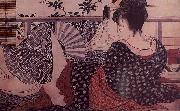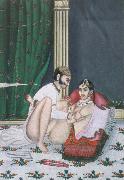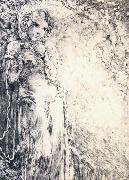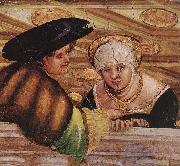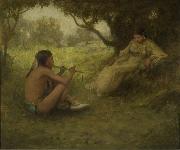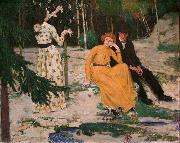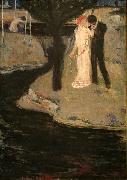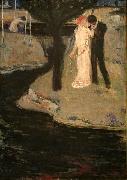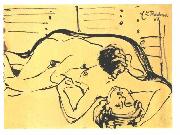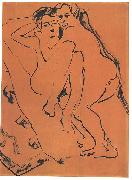Wholesale Oil Painting No Minimum |
|||||||||||
|
|
|||||||||||

|
|||||||||||
|
|
|
||||||||
Kitagawa UtamaroJapanese 1753-1806 Kitagawa Utamaro Gallery Biographical details for Utamaro are extremely limited, and each reference gives a substantially different account. Various accounts claim that he was born in either Edo (present-day Tokyo), Kyoto, or Osaka (the three main cities of Japan), or a provincial town (no one is sure exactly which one) in around 1753; the exact date is also uncertain. Another long-standing tradition has is that he was born in Yoshiwara, the courtesan district of Edo, the son of a tea-house owner, but there is no evidence of this. His original name was Kitagawa Ichitaro. It is generally agreed that he became a pupil of the painter Toriyama Sekien while he was still a child, and there are many authorities who believe that Utamaro was his son as well. He lived in Sekien's house while he was growing up, and the relationship continued until Sekien's death in 1788. Sekien was originally trained in the aristocratic Kan?? school of painting, but in middle age he started to lean toward the popular (or ukiyo-e) school. Sekien is known to have had a number of other pupils, none of any distinction. Utamaro, in common with other Japanese of the time, changed his name as he became mature, and also took the name Ichitaro Yusuke as he became older. He apparently also married, although little is known about his wife, and he apparently had no children. His first major professional artistic work, at about the age of 22, in 1775, seems to have been the cover for a Kabuki playbook, under the g?? of Toyoaki. He then produced a number of actor and warrior prints, along with theatre programmes, and other such material. From the spring of 1781, he switched his g?? to Utamaro, and started painting and designing fairly forgettable woodblock prints of women. At some point in the middle 1780s, probably 1783, he went to live with the young rising publisher Tsutaya J??zabur??, with whom he apparently lived for about 5 years. He seems to have become a principal artist for the Tsutaya firm. His output of prints for the next few years was sporadic, as he produced mostly illustrations for books of kyoka, literally 'crazy verse', a parody of the classical waka form. He seems to have produced nothing at all that has survived in the period 1790-1792. In about 1791 Utamaro gave up designing prints for books and concentrated on making half-length single portraits of women, rather than the prints of women in groups favoured by other ukiyo-e artists. In 1793 he achieved recognition as an artist, and his semi-exclusive arrangement with the publisher Tsutaya J??zabur?? was terminated. He then went on to produce a number of very famous series, all featuring women of the Yoshiwara district. Over the years, he also occupied himself with a number of volumes of nature studies and shunga, or erotica. In 1797, Tsutaya J??zabur?? died, and Utamaro apparently was very upset by the loss of his long-time friend and supporter. Some commentators feel that his work after this never reached the heights it did before. In 1804, at the height of his success, he ran into legal trouble by publishing prints related to a banned historical novel. The prints, entitled Hideyoshi and his 5 Concubines, depicted the military ruler Toyotomi Hideyoshi's wife and concubines; Consequently, he was accused of insulting Hideyoshi's dignity. He was sentenced to be handcuffed for 50 days (some accounts say he was briefly imprisoned). According to some sources, the experience crushed him emotionally and ended his career as an artist. He died two years later, on the 20th day of the 9th month, 1806, aged about fifty-three, in Edo. |
||||||||
|
|
||||||||
Lovers
Lovers Painting ID:: 3231 |
|
|||||||
|
|
||||||||
Jan Dirksz BothDutch 1610-1652 Jan Dirksz Both (between 1610 and 1618, Utrecht - Aug 9 1652, Utrecht), brother of Andries Both, was a Dutch painter. From 1634 to 1637 he was taught by Bloemaert and the painter Gerard van Honthorst before travelling to Rome ca. 1637. There he met the French painter Claude Lorrain, with whom he collaborated on a series of landscape paintings. His landscapes are typically peopled by peasants driving cattle or travellers gazing on Roman ruins in the light of the evening sun The everyday life of the streets of Rome became a favourite theme in his works. On his return to Utrecht after the death of his brother in 1642, he stopped producing genre pieces and focused instead on pictures of Italian landscapes bathed in a warm, golden light. This theme was adopted by several other Dutch painters, the Italianites. |
||||||||
|
|
||||||||
|
|
lovers
lovers Painting ID:: 56251 |
mk1860,watercolor on paper,sangram singh collection,city palace,jaipur,lndia mk1860,watercolor on paper,sangram singh collection,city palace,jaipur,lndia |
||||||
|
|
||||||||
Louis LcartFrench (1880-1950) Louis Icart was born in Toulouse, France. He began drawing at an early age. He was particularly interested in fashion, and became famous for his sketches almost immediately. He worked for major design studios at a time when fashion was undergoing a radical change-from the fussiness of the late nineteenth century to the simple, clingy lines of the early twentieth century. He was first son of Jean and Elisabeth Icart and was officially named Louis Justin Laurent Icart. The use of his initials L.I. would be sufficient in this household. Therefore, from the moment of his birth he was dubbed 'Helli'. The Icart family lived modestly in a small brick home on rue Traversi??re-de-la-balance, in the culturally rich Southern French city of Toulouse, which was the home of many prominent writers and artists, the most famous being Henri de Toulouse-Lautrec. Icart fought in World War I. He relied on his art to stem his anguish, sketching on every available surface. It was not until his move to Paris in 1907 that Icart would concentrate on painting, drawing and the production of countless beautiful etchings, which have served (more than the other mediums) to indelibly preserve his name in twentieth century art history. When he returned from the front he made prints from those drawings. The prints, most of which were aquatints and drypoints, showed great skill. Because they were much in demand, Icart frequently made two editions (one European, the other American) to satisfy his public. These prints are considered rare today, and when they are in mint condition they fetch high prices at auction. Art Deco, a term coined at the 1925 Paris Exposition des Arts Decoratifs, had taken its grip on the Paris of the 1920s. By the late 1920s Icart, working for both publications and major fashion and design studios, had become very successful, both artistically and financially. His etchings reached their height of brilliance in this era of Art Deco, and Icart had become the symbol of the epoch. Yet, although Icart has created for us a picture of Paris and New York life in the 1920s and 1930s, he worked in his own style, derived principally from the study of eighteenth-century French masters such as Jean Antoine Watteau, François Boucher and Jean Honor?? Fragonard. In Icart's drawings, one sees the Impressionists Degas and Monet and, in his rare watercolors, the Symbolists Odilon Redon and Gustave Moreau. In fact, Icart lived outside the fashionable artistic movements of the time and was not completely sympathetic to contemporary art. Nonetheless, his Parisian scenes are a documentation of the life he saw around him and they are nearly as popular today as when they were first produced. In 1914 Icart had met a magical, effervescent eighteen-year-old blonde named Fanny Volmers, at the time an employee of the fashion house Paquin. She would eventually become his wife and a source of artistic inspiration for the rest of his life. |
||||||||
|
|
||||||||
|
|
Lovers
Lovers Painting ID:: 63423 |
mk286 13.5 x 19 cm 1918 mk286 13.5 x 19 cm 1918 |
||||||
|
|
||||||||
Louis LcartFrench (1880-1950) Louis Icart was born in Toulouse, France. He began drawing at an early age. He was particularly interested in fashion, and became famous for his sketches almost immediately. He worked for major design studios at a time when fashion was undergoing a radical change-from the fussiness of the late nineteenth century to the simple, clingy lines of the early twentieth century. He was first son of Jean and Elisabeth Icart and was officially named Louis Justin Laurent Icart. The use of his initials L.I. would be sufficient in this household. Therefore, from the moment of his birth he was dubbed 'Helli'. The Icart family lived modestly in a small brick home on rue Traversi??re-de-la-balance, in the culturally rich Southern French city of Toulouse, which was the home of many prominent writers and artists, the most famous being Henri de Toulouse-Lautrec. Icart fought in World War I. He relied on his art to stem his anguish, sketching on every available surface. It was not until his move to Paris in 1907 that Icart would concentrate on painting, drawing and the production of countless beautiful etchings, which have served (more than the other mediums) to indelibly preserve his name in twentieth century art history. When he returned from the front he made prints from those drawings. The prints, most of which were aquatints and drypoints, showed great skill. Because they were much in demand, Icart frequently made two editions (one European, the other American) to satisfy his public. These prints are considered rare today, and when they are in mint condition they fetch high prices at auction. Art Deco, a term coined at the 1925 Paris Exposition des Arts Decoratifs, had taken its grip on the Paris of the 1920s. By the late 1920s Icart, working for both publications and major fashion and design studios, had become very successful, both artistically and financially. His etchings reached their height of brilliance in this era of Art Deco, and Icart had become the symbol of the epoch. Yet, although Icart has created for us a picture of Paris and New York life in the 1920s and 1930s, he worked in his own style, derived principally from the study of eighteenth-century French masters such as Jean Antoine Watteau, François Boucher and Jean Honor?? Fragonard. In Icart's drawings, one sees the Impressionists Degas and Monet and, in his rare watercolors, the Symbolists Odilon Redon and Gustave Moreau. In fact, Icart lived outside the fashionable artistic movements of the time and was not completely sympathetic to contemporary art. Nonetheless, his Parisian scenes are a documentation of the life he saw around him and they are nearly as popular today as when they were first produced. In 1914 Icart had met a magical, effervescent eighteen-year-old blonde named Fanny Volmers, at the time an employee of the fashion house Paquin. She would eventually become his wife and a source of artistic inspiration for the rest of his life. |
||||||||
|
|
||||||||
|
|
Lovers
Lovers Painting ID:: 63498 |
mk286 35.5 x 53.3 cm 1930 mk286 35.5 x 53.3 cm 1930 |
||||||
|
|
||||||||
ALTDORFER, AlbrechtGerman Northern Renaissance Painter, ca.1480-1538 Albrecht Altdorfer (c. 1480 near Regensburg ?C 12 February 1538 in Regensburg) was a German painter, printmaker and architect of the Renaissance era, the leader of the Danube School in southern Germany, and a near-contemporary of Albrecht D??rer. He is best known as a significant pioneer of landscape in art. He most often painted religious scenes, but is mainly famous as the first frequent painter of pure landscape, and also compositions dominated by their landscape. Taking and developing the landscape style of Lucas Cranach the Elder, he shows the hilly landscape of the Danube valley with thick forests of drooping and crumbling firs and larches hung with moss, and often dramatic colouring from a rising or setting sun. His Landscape with footbridge (National Gallery, London) of 1518-20 is claimed to be the first pure landscape in oil. [1] He also made many fine finished drawings, mostly landscapes, in pen and watercolour. His best religious scenes are intense, sometimes verging on the expressionistic, and often depict moments of intimacy between Christ and his mother, or others. His most famous religious artwork is the The Legend of St. Sebastian and the Passion of Christ that decorated the altar in the St. Florian monastery in Linz, Austria. He often distorts perspective to subtle effect. His donor figures are often painted completely out of scale with the main scene, as in paintings of the previous centuries. He also painted some portraits; overall his painted oeuvre was not large. |
||||||||
|
|
||||||||
|
|
Lovers
Lovers Painting ID:: 63550 |
1530 Fresco, 36 x 40 cm Museum of Fine Arts, Budapest This fragment of a fresco was executed for the decoration of Kaiserbad in Regensburg. (Other fragments are in the St?dtishes Museum, Regensburg). The importance is given to these fragments by the fact that no wall other wall paintings survived from the masters of the Danube school (except a damaged fresco by Wolf Huber in Neuburg am Inn.Artist:ALTDORFER, Albrecht Title: Lovers Painted in 1501-1550 , German - - painting : other 1530 Fresco, 36 x 40 cm Museum of Fine Arts, Budapest This fragment of a fresco was executed for the decoration of Kaiserbad in Regensburg. (Other fragments are in the St?dtishes Museum, Regensburg). The importance is given to these fragments by the fact that no wall other wall paintings survived from the masters of the Danube school (except a damaged fresco by Wolf Huber in Neuburg am Inn.Artist:ALTDORFER, Albrecht Title: Lovers Painted in 1501-1550 , German - - painting : other |
||||||
|
|
||||||||
Eanger Irving CouseAmerican Painter , b.1866 d.1936 was an artist and founding member of the Taos artists colony in Taos, New Mexico. Couse was born in Saginaw, Michigan, where he first started drawing the Chippewa Indians who lived nearby. Couse attended the Art Institute of Chicago, and the National Academy of Design, New York. He left for Paris to study at the Ecole des Beaux-Arts and Academie Julian under Bouguereau. He lived in France 10 years, where he painted charming scenes of the Normandy coast. After his return to America he devoted himself to depicting the life and habits of the Taos Indians, a pueblo tribe in New Mexico. He reveals the poetical and philosophical rather than the savage and warlike side of the Indians, and his skillfully executed pictures are full of sentiment. |
||||||||
|
|
||||||||
|
|
Lovers
Lovers Painting ID:: 70234 |
Medium Oil on canvas
Dimensions 061.3 X 73.8 cm
Medium Oil on canvas Dimensions 061.3 X 73.8 cm |
||||||
|
|
||||||||
Jan PreislerCzechoslovakian, 1872-1918 Bohemian painter. He studied at the School of Applied Arts in Prague (1887-95). In 1906 he visited Belgium, the Netherlands and Paris. He taught at the Academy of Arts in Prague from 1913. He was a pioneer in modern Bohemian art, and his work developed from pure Art Nouveau and Symbolism towards Expressionism, in three phases. The period 1887-1900 is represented by the triptych Spring (1900; Prague, Trade Fair Pal.): with its lack of scales of tonal value or Impressionist instantaneousness, it is a skilful use of colour and composition. The figure of the boy with autobiographical features is symbolic of a whole generation. The period 1901-7 culminated in Painting from a Bigger Cycle (1901-2; Prague, Trade Fair Pal.), which balances vertical and horizontal lines and employs bright colour combinations. In Black Lake (1904; Prague, Trade Fair Pal.), which deals with the misery and excitement of first love, the contrast of black and white and the figure of the boy with a horse and a girl evoke the transitive moment between reality and dream. Spring (1906; Prague, Trade Fair Pal.), a testament to Preisler admiration for the work of Gauguin, develops the resonant contrast of green, yellow and white. In 1908-18 Preisler returned to monumental decoration: of the Palacky Room in the Municipal House in Prague, 1910-12, in the style of Puvis de Chavannes. At this time he was approaching the Expressionism of the younger generation from the Eight (ii), especially in the three versions of the painting Good Samaritan (1910-13; all priv. col., see Kotalok, pl. 41), which shows the influence of Daumier and Munch. |
||||||||
|
|
||||||||
|
|
Lovers
Lovers Painting ID:: 82866 |
Date 1905(1905)
Medium Oil on canvas
Dimensions 120 x 150 cm (47.2 x 59.1 in)
cjr Date 1905(1905) Medium Oil on canvas Dimensions 120 x 150 cm (47.2 x 59.1 in) cjr |
||||||
|
|
||||||||
Jan PreislerCzechoslovakian, 1872-1918 Bohemian painter. He studied at the School of Applied Arts in Prague (1887-95). In 1906 he visited Belgium, the Netherlands and Paris. He taught at the Academy of Arts in Prague from 1913. He was a pioneer in modern Bohemian art, and his work developed from pure Art Nouveau and Symbolism towards Expressionism, in three phases. The period 1887-1900 is represented by the triptych Spring (1900; Prague, Trade Fair Pal.): with its lack of scales of tonal value or Impressionist instantaneousness, it is a skilful use of colour and composition. The figure of the boy with autobiographical features is symbolic of a whole generation. The period 1901-7 culminated in Painting from a Bigger Cycle (1901-2; Prague, Trade Fair Pal.), which balances vertical and horizontal lines and employs bright colour combinations. In Black Lake (1904; Prague, Trade Fair Pal.), which deals with the misery and excitement of first love, the contrast of black and white and the figure of the boy with a horse and a girl evoke the transitive moment between reality and dream. Spring (1906; Prague, Trade Fair Pal.), a testament to Preisler admiration for the work of Gauguin, develops the resonant contrast of green, yellow and white. In 1908-18 Preisler returned to monumental decoration: of the Palacky Room in the Municipal House in Prague, 1910-12, in the style of Puvis de Chavannes. At this time he was approaching the Expressionism of the younger generation from the Eight (ii), especially in the three versions of the painting Good Samaritan (1910-13; all priv. col., see Kotalok, pl. 41), which shows the influence of Daumier and Munch. |
||||||||
|
|
||||||||
|
|
Lovers
Lovers Painting ID:: 82881 |
Date 1904(1904)
Medium Oil on canvas
Dimensions 102 x 72 cm (40.2 x 28.3 in)
cjr Date 1904(1904) Medium Oil on canvas Dimensions 102 x 72 cm (40.2 x 28.3 in) cjr |
||||||
|
|
||||||||
Jan PreislerCzechoslovakian, 1872-1918 Bohemian painter. He studied at the School of Applied Arts in Prague (1887-95). In 1906 he visited Belgium, the Netherlands and Paris. He taught at the Academy of Arts in Prague from 1913. He was a pioneer in modern Bohemian art, and his work developed from pure Art Nouveau and Symbolism towards Expressionism, in three phases. The period 1887-1900 is represented by the triptych Spring (1900; Prague, Trade Fair Pal.): with its lack of scales of tonal value or Impressionist instantaneousness, it is a skilful use of colour and composition. The figure of the boy with autobiographical features is symbolic of a whole generation. The period 1901-7 culminated in Painting from a Bigger Cycle (1901-2; Prague, Trade Fair Pal.), which balances vertical and horizontal lines and employs bright colour combinations. In Black Lake (1904; Prague, Trade Fair Pal.), which deals with the misery and excitement of first love, the contrast of black and white and the figure of the boy with a horse and a girl evoke the transitive moment between reality and dream. Spring (1906; Prague, Trade Fair Pal.), a testament to Preisler admiration for the work of Gauguin, develops the resonant contrast of green, yellow and white. In 1908-18 Preisler returned to monumental decoration: of the Palacky Room in the Municipal House in Prague, 1910-12, in the style of Puvis de Chavannes. At this time he was approaching the Expressionism of the younger generation from the Eight (ii), especially in the three versions of the painting Good Samaritan (1910-13; all priv. col., see Kotalok, pl. 41), which shows the influence of Daumier and Munch. |
||||||||
|
|
||||||||
|
|
Lovers
Lovers Painting ID:: 86720 |
1904(1904)
Medium Oil on canvas
Dimensions 102 x 72 cm (40.2 x 28.3 in)
cyf 1904(1904) Medium Oil on canvas Dimensions 102 x 72 cm (40.2 x 28.3 in) cyf |
||||||
|
|
||||||||
Ernst Ludwig KirchnerGerman Expressionist Painter and Sculptor, 1880-1938 was a German expressionist painter and printmaker and one of the founders of the artists group Die Brucke or "The Bridge", a key group leading to the foundation of Expressionism in 20th century art. He volunteered for army service in the First World War, but soon suffered a breakdown and was discharged. In 1933, his work was branded as "degenerate" by the Nazis and in 1937 over 600 of his works were sold or destroyed. In 1938 he committed suicide. In 1913, the first public showing of Kirchner's work took place at the Armory Show, which was also the first major display of modern art in America. In 1921, U.S. museums began to acquire his work and did so increasingly thereafter. His first solo show was at the Detroit Institute of Arts in 1937. In 1992, the National Gallery of Art, Washington, held a monographic show, using its existing collection; a major international loan exhibition took place in 2003. In November 2006 at Christie's, Kirchner's Street Scene, Berlin (1913) fetched $38 million, a record for the artist. |
||||||||
|
|
||||||||
|
|
Lovers
Lovers Painting ID:: 94219 |
Date 1903
TTD Date 1903 TTD |
||||||
|
|
||||||||
Ernst Ludwig KirchnerGerman Expressionist Painter and Sculptor, 1880-1938 was a German expressionist painter and printmaker and one of the founders of the artists group Die Brucke or "The Bridge", a key group leading to the foundation of Expressionism in 20th century art. He volunteered for army service in the First World War, but soon suffered a breakdown and was discharged. In 1933, his work was branded as "degenerate" by the Nazis and in 1937 over 600 of his works were sold or destroyed. In 1938 he committed suicide. In 1913, the first public showing of Kirchner's work took place at the Armory Show, which was also the first major display of modern art in America. In 1921, U.S. museums began to acquire his work and did so increasingly thereafter. His first solo show was at the Detroit Institute of Arts in 1937. In 1992, the National Gallery of Art, Washington, held a monographic show, using its existing collection; a major international loan exhibition took place in 2003. In November 2006 at Christie's, Kirchner's Street Scene, Berlin (1913) fetched $38 million, a record for the artist. |
||||||||
|
|
||||||||
|
|
Lovers
Lovers Painting ID:: 94398 |
Date Unknown Date Unknown |
||||||
|
|
||||||||
|
Ernst Ludwig Kirchner German Expressionist Painter and Sculptor, 1880-1938 was a German expressionist painter and printmaker and one of the founders of the artists group Die Brucke or "The Bridge", a key group leading to the foundation of Expressionism in 20th century art. He volunteered for army service in the First World War, but soon suffered a breakdown and was discharged. In 1933, his work was branded as "degenerate" by the Nazis and in 1937 over 600 of his works were sold or destroyed. In 1938 he committed suicide. In 1913, the first public showing of Kirchner's work took place at the Armory Show, which was also the first major display of modern art in America. In 1921, U.S. museums began to acquire his work and did so increasingly thereafter. His first solo show was at the Detroit Institute of Arts in 1937. In 1992, the National Gallery of Art, Washington, held a monographic show, using its existing collection; a major international loan exhibition took place in 2003. In November 2006 at Christie's, Kirchner's Street Scene, Berlin (1913) fetched $38 million, a record for the artist. Lovers Date Unknown |
||||||||
|
|
||||||||
|
Prev Next
|
||||||||
|
|
||||||||
|
Related Paintings to Ernst Ludwig Kirchner :. |
||||||||
|
|
||||||||
|
CONTACT US |
